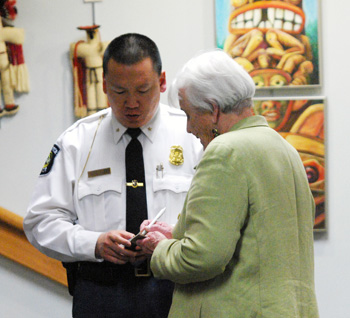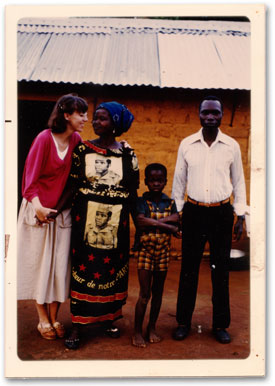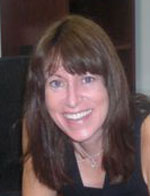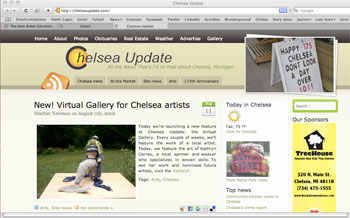Final Forum: What Sustains Community?
The fourth and final forum in a series on sustainability in Ann Arbor focused on community, touching on topics that contribute to a stronger social fabric – quality of life, public safety, housing, and parks.

Interim Ann Arbor police chief John Seto talks with Eunice Burns, a longtime activist who attended an April 12 sustainability forum at the Ann Arbor District Library. Seto was a panelist at the forum, which focused on building a sustainable community. (Photos by the writer.)
Community is one of four categories in a framework that’s been developed over the past year, with the intent of setting sustainability goals for the city. Other categories – which have been the focus of three previous forums this year – are resource management; land use and access; climate and energy; and community.
At the April 12 forum on community, Wendy Rampson – the city’s planning manager, who moderated the discussion – told the audience that 15 draft goals have been selected from more than 200 already found in existing city planning documents. The hope is to reach consensus on these sustainability goals, then present them to the city council as possible amendments to the city’s master plan. The goals are fairly general – if approved, they would be fleshed out with more detailed objectives and action items. [.pdf of draft sustainability goals]
Rampson said that although this would be the final forum in this year’s series, there seems to be interest in having an annual sustainability event – so this would likely not be the last gathering.
The forum was held at the Ann Arbor District Library’s downtown building, and attended by about 50 people. Panelists were Dick Norton, chair of the University of Michigan urban and regional planning program; Cheryl Elliott, president of the Ann Arbor Area Community Foundation; John Seto, Ann Arbor’s interim chief of police; Jennifer L. Hall, executive director of the Ann Arbor Housing Commission; Julie Grand, chair of the city’s park advisory commission; and Cheryl Saam, facility supervisor for the Ann Arbor canoe liveries.
Several comments during the Q & A session centered on the issue of housing density within the city. Eunice Burns, a long-time local activist and former Ann Arbor city councilmember, advocated for more flexibility in accessory apartments.
Doug Kelbaugh, a UM professor of architecture and urban planning, supported her view and wondered whether the city put too high a priority on parks, when what Ann Arbor really needs is more people living downtown. He said a previous attempt to revise zoning and allow for more flexibility in accessory units was shot down by a “relatively small, relatively wealthy, relatively politically-connected group. I don’t think it was a fair measure of community sentiment.”
Also during the Q & A period, Pete Wangwongwiroj – a board member of UM’s student sustainability initiative – advocated for the concept of gross national happiness to be a main consideration in public policy decisions.
The April forum was videotaped by AADL staff and will be posted on the library’s website – videos of the three previous sessions are already posted: on resource management (Jan. 12); land use and access (Feb. 9); and climate and energy (March 8). Additional background on the Ann Arbor sustainability initiative is on the city’s website. See also Chronicle coverage: “Building a Sustainable Ann Arbor,” “Sustaining Ann Arbor’s Environmental Quality” and “Land Use, Transit Factor Into Sustainability.” [Full Story]








